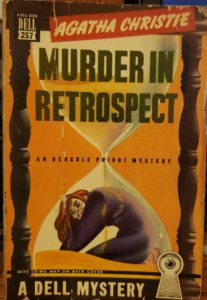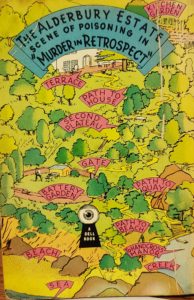
I continue to work my way through books in the house with an eye toward reducing our inventory, selecting some for reading and discarding. With around 4000 to 5000 books in the house, we are making slow progress—but we are making some.
A while back I transferred some books slated for donation from shoe boxes to plastic bags (because the wife doesn’t like to discard shoe boxes). Then the pandemic hit and we haven’t been to a thrift store since. Hence the two bags of books still sit in our garage. On top of one was an Agatha Christie mystery. I thought maybe we could read that aloud together and we did so. When I returned it to the pending donation bag, I dug a little deeper and found three other Agatha Christie books. Having enjoyed the first, I rescued these (along with three other books) and formed a new reading pile for our evening reading.

This one was Murder In Retrospect. Originally copyrighted in 1941, my copy, a mass-market paperback, doesn’t have a printing date. It appears to be from the 1960s, just like the other one we read. MIR is a Hercule Poirot mystery. Poirot is hired by a woman who has just come of age and is planning on marrying. But, when she was five, her mother was convicted of killing her father by poisoning, was sentenced to prison, but died there within a year. She left a note for her daughter, proclaiming her innocence. Except by all reports, during the trial she made a very poor witness for herself, which was a significant factor in her being convicted. Now, before the daughter marries, she wants to know the truth and hires Poirot to investigate.
What ensues is Poirot interviewing the surviving parties, sixteen years after it happened, to discover the truth if it can be found. The woman’s father was a painter—and a philanderer. He was painting his latest fling, in their own house so to speak, or at least in the garden. Other parties are: the woman’s 15-year-old aunt, half-sister to her mother; the governess; two brothers who lived at an adjacent country property; and the woman who was being painted. Also to be interviewed are various police officers who worked the case.

The book was a fascinating, easy read of 239 pages that we read in eleven sittings. It was a real opportunity for the reader to try to figure out who did the murder. I decided right away that the accused/convicted didn’t do it, but couldn’t decide on who it was among the other six. I don’t want to give it away by saying too much, just in case one of my readers wants to read it. I was leaning toward one person, but then a late clue led me to conclude it was another. I felt pretty good about myself recognizing that clue (which I figured out about an hour after reading, just after I’d gone to bed). It was an important clue, not because it told you who the murderer was, but because it let you know who the accused thought the murderer was and thus governed her subsequent actions.
This was a good Christie mystery and I’m glad I read it. If I didn’t already have so many books in the house, I might have kept this. Alas, it goes back into the donation bag. Someday we will get to a thrift store once again and it will go on a shelf for someone else to read.
If there are any Little Free Libraries in your vicinity, that is a wonderful way to share the books. https://littlefreelibrary.org
There are a few such libraries, but mostly they are 15 miles or so away.